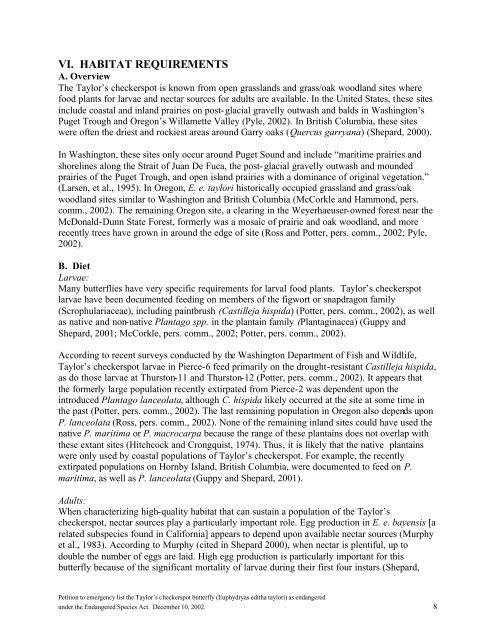petition to emergency list taylor's (whulge) checkerspot - The Xerces ...
petition to emergency list taylor's (whulge) checkerspot - The Xerces ...
petition to emergency list taylor's (whulge) checkerspot - The Xerces ...
Create successful ePaper yourself
Turn your PDF publications into a flip-book with our unique Google optimized e-Paper software.
VI. HABITAT REQUIREMENTS<br />
A. Overview<br />
<strong>The</strong> Taylor’s <strong>checkerspot</strong> is known from open grasslands and grass/oak woodland sites where<br />
food plants for larvae and nectar sources for adults are available. In the United States, these sites<br />
include coastal and inland prairies on post-glacial gravelly outwash and balds in Washing<strong>to</strong>n’s<br />
Puget Trough and Oregon’s Willamette Valley (Pyle, 2002). In British Columbia, these sites<br />
were often the driest and rockiest areas around Garry oaks (Quercus garryana) (Shepard, 2000).<br />
In Washing<strong>to</strong>n, these sites only occur around Puget Sound and include “maritime prairies and<br />
shorelines along the Strait of Juan De Fuca, the post-glacial gravelly outwash and mounded<br />
prairies of the Puget Trough, and open island prairies with a dominance of original vegetation.”<br />
(Larsen, et al., 1995). In Oregon, E. e. taylori his<strong>to</strong>rically occupied grassland and grass/oak<br />
woodland sites similar <strong>to</strong> Washing<strong>to</strong>n and British Columbia (McCorkle and Hammond, pers.<br />
comm., 2002). <strong>The</strong> remaining Oregon site, a clearing in the Weyerhaeuser-owned forest near the<br />
McDonald-Dunn State Forest, formerly was a mosaic of prairie and oak woodland, and more<br />
recently trees have grown in around the edge of site (Ross and Potter, pers. comm., 2002; Pyle,<br />
2002).<br />
B. Diet<br />
Larvae:<br />
Many butterflies have very specific requirements for larval food plants. Taylor’s <strong>checkerspot</strong><br />
larvae have been documented feeding on members of the figwort or snapdragon family<br />
(Scrophulariaceae), including paintbrush (Castilleja hispida) (Potter, pers. comm., 2002), as well<br />
as native and non-native Plantago spp. in the plantain family (Plantaginacea) (Guppy and<br />
Shepard, 2001; McCorkle, pers. comm., 2002; Potter, pers. comm., 2002).<br />
According <strong>to</strong> recent surveys conducted by the Washing<strong>to</strong>n Department of Fish and Wildlife,<br />
Taylor’s <strong>checkerspot</strong> larvae in Pierce-6 feed primarily on the drought-resistant Castilleja hispida,<br />
as do those larvae at Thurs<strong>to</strong>n-11 and Thurs<strong>to</strong>n-12 (Potter, pers. comm., 2002). It appears that<br />
the formerly large population recently extirpated from Pierce-2 was dependent upon the<br />
introduced Plantago lanceolata, although C. hispida likely occurred at the site at some time in<br />
the past (Potter, pers. comm., 2002). <strong>The</strong> last remaining population in Oregon also depends upon<br />
P. lanceolata (Ross, pers. comm., 2002). None of the remaining inland sites could have used the<br />
native P. maritima or P. macrocarpa because the range of these plantains does not overlap with<br />
these extant sites (Hitchcock and Crongquist, 1974). Thus, it is likely that the native plantains<br />
were only used by coastal populations of Taylor’s <strong>checkerspot</strong>. For example, the recently<br />
extirpated populations on Hornby Island, British Columbia, were documented <strong>to</strong> feed on P.<br />
maritima, as well as P. lanceolata (Guppy and Shepard, 2001).<br />
Adults:<br />
When characterizing high-quality habitat that can sustain a population of the Taylor’s<br />
<strong>checkerspot</strong>, nectar sources play a particularly important role. Egg production in E. e. bayensis [a<br />
related subspecies found in California] appears <strong>to</strong> depend upon available nectar sources (Murphy<br />
et al., 1983). According <strong>to</strong> Murphy (cited in Shepard 2000), when nectar is plentiful, up <strong>to</strong><br />
double the number of eggs are laid. High egg production is particularly important for this<br />
butterfly because of the significant mortality of larvae during their first four instars (Shepard,<br />
Petition <strong>to</strong> <strong>emergency</strong> <strong>list</strong> the Taylor’s <strong>checkerspot</strong> butterfly (Euphydryas editha taylori) as endangered<br />
under the Endangered Species Act. December 10, 2002. 8
















